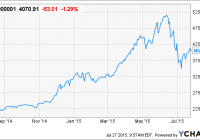Forget Semiconductor ETFs, Try Other Options In The Tech Space
The technology sector saw pretty choppy trading ahead of the Q2 earnings season, with most tech ETFs falling by the wayside. The sector is likely to see lower earnings in Q2, relative to the same-period last year. The sector posted 6.2% earnings growth in Q1 while it is expected to post a decline of 4.9% in Q2. The chances of the Fed rate hike coming sometime later in 2015, global growth worries, the rout in the Chinese market, the ongoing Greek debt crisis strengthened the risk-off trade sentiment in the market and took the shine out of the cyclical tech stocks. While the impact was broad based, semiconductor stocks had to bear the brunt, having bled the most in the tech sector. The semiconductor space was investors’ darling and one of the best performing sectors in 2014, courtesy encouraging industry fundamentals. But, of late, its fundamentals have worsened with the struggling PC market. The second quarter of 2015 witnessed PC shipments falling 9.5% year over year, marking the steepest decline since the third-quarter 2013, per Gartner (read: Chipmakers Q1 Earnings Fail to Fuel Semiconductor ETFs ). A strong greenback, higher inventories in the semiconductor and electronics supply chain and the launch of Windows 10 were held responsible for this decline, per the research agency. In fact, these factors will continue to remain an overhang on PC shipments in the rest of 2015. This coupled with semiconductor giant Intel Corporation’s (NASDAQ: INTC ) underperformance wreaked havoc in the space. The INTC stock is down over 18% this year (as of July 14, 2015). Over the last one month, the stock has shed about 5.5%. Though Micron Technology’s (NASDAQ: MU ) (stock is down 44% YTD as of July 14, 2015) potential takeover deal could push semiconductors in the short term; overall sentiment remains grim. If this was not enough, IBM’s (NYSE: IBM ) successful development of 7-nanometer chips might act as another deterrent to chip market leader Intel’s growth. Semiconductor ETFs including SPDR S&P Semiconductor ETF (NYSEARCA: XSD ), Market Vectors Semiconductor ETF (NYSEARCA: SMH ), and iShares PHLX SOX Semiconductor Sector Index ETF (NASDAQ: SOXX ) were down 9.7%, 6.7% and 6%, respectively in the last one month. Where Does the Focus Shift to Now? While the semiconductor sell-off continued to weigh on the tech space, the Internet, mobile, and broad social media markets have survived the recent sell-off pretty well. Below, we have highlighted three such ETFs in detail (read: ETF Strategies for 2H ): PowerShares NASDAQ Internet Portfolio ETF (NASDAQ: PNQI ) This ETF tracks the NASDAQ Internet Index, a benchmark of about 97 companies in the Internet segment of the economy. The product has about $223.5 million in assets, though volume is a little light at around 20,000 shares a day. Internet software and services make up about 61% of the portfolio while Internet retail constitutes about 34% of the fund. Large caps do account for roughly half the assets while growth stocks account for roughly 75% of PNQI. Top three holdings include Facebook (NASDAQ: FB ), Amazon.com (NASDAQ: AMZN ) and Google (NASDAQ: GOOG ) (NASDAQ: GOOGL ) with over 25% exposure of the total. PNQI is up about 12% year-to-date and added about 3.2% in the last one week (as of July 14, 2015). However, PNQI has a Zacks ETF Rank #4 (Sell) with a High risk outlook. First Trust DJ Internet Index ETF (NYSEARCA: FDN ) This fund follows the Dow Jones Internet Index, a cap weighted benchmark of Internet companies based in the U.S. market. FDN is pretty popular with investors, as over $3.08 billion is invested in the product while average daily volume is over 260,000 shares a day. Information Technology accounts for over half the portfolio, followed closely by Consumer Discretionary at 25% of assets. Facebook (10%), Amazon (9.69%) and eBay (NASDAQ: EBAY ) (6.1%) are the fund’s top three holdings. The fund charges 57 bps in fees. The fund is up 13.4% so far this year and added over 2.8% in the last one week. The fund has a Zacks ETF Rank #3 (Hold) with a High risk outlook. iShares North American Tech-Software ETF (NYSEARCA: IGV ) This ETF provides exposure to the software segment of the broader U.S. technology space by tracking the S&P North American Technology-Software Index. The fund holds a basket of 63 securities. It is quite popular with AUM of over $1.2 billion while volume is moderate as it exchanges nearly 120,000 shares a day. The product charges 47 bps in annual fees and has gained about 9.8% so far this year. The fund was up 2.7% in the last one week. IGV has a Zacks ETF Rank #3 with a High risk outlook. Bottom Line The broader technology sector may be lagging, but not the specialized corners of Internet and software. Firms in this corner of the market have led the way higher, and have seen market-leading performances over the past week. Thus, a look at the aforementioned ETFs could be a way to earn smart gains out of a slackening sector (read: Beyond XLK: 3 Great Tech ETFs ). Original post
